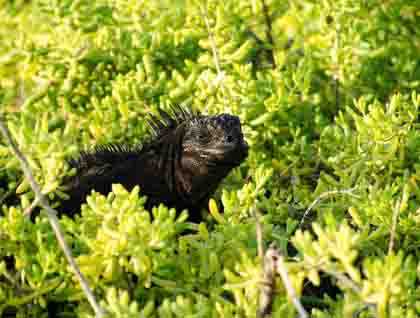Last night, the National Geographic Endeavour navigated from Puerto Ayora on the southern side of Santa Cruz Island, to the much more sheltered channel between Santa Cruz and Santiago Island.
As the sun was rising this morning, our captain John Zurita sailed our ship into the anchorage off of a visitor’s site called Dragon Hill. This tranquil shoreline on the leeward side of Santa Cruz, the second largest Island in the archipelago, is home to a healthy population of marine iguanas and land iguanas. These two creatures rarely meet in the wild, since their ancestors became so well-accustomed to two neighboring, but very different, environments.
Soon after anchoring, we departed for an invigorating pre-breakfast hike around Dragon Hill in search of Conolophus subcristatus, the Galapagos land iguana, the most widespread and numerous of the three land iguana species that inhabit this group of islands. We hiked through a belt of intense greenery that follows the shoreline, where we came across multiple marine iguanas who seemed to be making their way towards the beach as the tide was receding. Low tide is the marine iguanas preferred time of day for foraging.
As we passed a brackish water lagoon, shore birds of various kinds where already very active, and a small group of flamingos, in particular, caught our attention. Our early morning walk through the inland proved very successful, as various groups also had the opportunity to see several land iguanas as they emerged from the dugouts.
We returned to our ship for breakfast and a short rest before heading back out again, for a chance to snorkel around the Guy Fawkes Islets, which are a little over a mile to the northwest of Dragon Hill. The water was warm and visibility was excellent. We spotted several white-tipped reef sharks along the volcanic rock reef, filled with black corals and many other colorful invertebrates which serve as food and shelter to a myriad of different fish.
During the afternoon, we had a chance to explore the surroundings of Eden Islet further to the west, and the staff offered Zodiac driving lessons to some of the kids onboard. Afterwards, we continued to sail back east towards Daphne Major and Daphne Minor, for a sunset circumnavigation of these iconic islets. As we neared our destination, a short documentary on the work and discoveries of Peter and Rosemary Grant on Daphne Major had to be momentarily paused, as a small group of bottlenose dolphins decided to escort us for several minutes.
You never know what surprises await us around the next corner or islet on the horizon. Whatever lies ahead will only make this expedition even more memorable!







